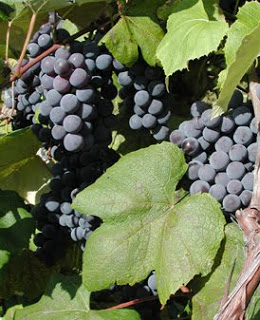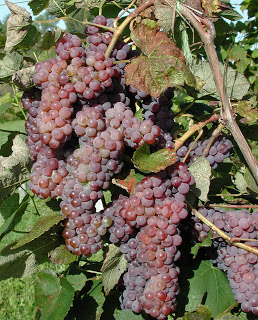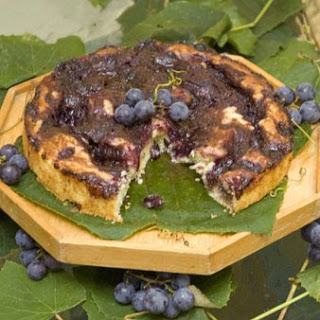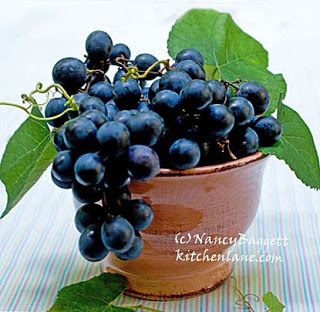One of my favorite seasonal signs that autumn is almost here is the appearance of Concord grapes in my local markets. The very beautiful ones pictured above I discovered in a nearby farmer’s market. They appeared to be Concords, but were not! The vendor said that they were actually, “Thomcords–a cross between Thompson seedless and Concords.” The advantage, she explained, was that they were seedless so you could, “eat them without either continually crunching or spitting out seeds.”
Since I’ve always loved fresh Concords but never liked dealing with the seeds this was good news. Even better news–they taste like slightly mild, but still fruity and very sweet Concords. Another plus: The skins are fairly tender and similar to those of the very popular Thompson seedless green table grapes, not Concords which can have slightly tough skins.
 Actually hybridization of grapes is common, and there a many delicious little known kinds as I learned when I visited the New York Finger Lakes region in the fall a few years ago.
Actually hybridization of grapes is common, and there a many delicious little known kinds as I learned when I visited the New York Finger Lakes region in the fall a few years ago.The grapes in the photos at left and below were growing in a 5-acre table grape vineyard north of Naples, New York (shown right) The owner, Len Barron, not only let me take pictures and wander through his tidy, well-tended rows of vines, but pointed out his 15 different American green, red, and purple varieties and gave me all the tasting samples I could eat.

 The names he rattled off were mostly unfamiliar—VanBuren, Steuben, Fredonia, Sheridan, Lakemont, and Price—although he also raises Concords, seedless Concords, whitish green Niagara and burnished rose Canadice, which I’d tasted the day before. Every kind I tried was sweet, succulent, and full of the grapey, “foxy” flavor and aroma that our labrusca species of grapes is famous for.
The names he rattled off were mostly unfamiliar—VanBuren, Steuben, Fredonia, Sheridan, Lakemont, and Price—although he also raises Concords, seedless Concords, whitish green Niagara and burnished rose Canadice, which I’d tasted the day before. Every kind I tried was sweet, succulent, and full of the grapey, “foxy” flavor and aroma that our labrusca species of grapes is famous for.The native vines thrive in the Finger Lakes climate, as my pics make clear. The biggest natural threat is from deer, so Len has Toby, a friendly half-Lab, half-German shepherd watch dog trained to keep the hungry foragers away. “He loves his job and is very good at it.” Len says.
 I’d made jelly, juice, and sorbet with Concord grapes before I visited the Finger Lakes, but during the annual Naples Grape Festival was able to sample muffins, cookies and this kuchen, too. The recipe for Concord grape kuchen shown is here.
I’d made jelly, juice, and sorbet with Concord grapes before I visited the Finger Lakes, but during the annual Naples Grape Festival was able to sample muffins, cookies and this kuchen, too. The recipe for Concord grape kuchen shown is here.BTW, the Concord is named for Concord, MA, where the variety was developed by an Ephriam Bull. His name may not be familiar, but the creator of the first bottled Concord juice is–it’s Thomas Welch! Part of the success of his product is probably the Temperance Movement–his first customers were churches seeking a non-alcoholic Communion wine. Who knew!


Sorry not to have responded sooner. With the Foccacia I have found that the herbs have an inhibiting effect on the yeast–so it is very important not to stir them in, just sprinkle over top, as directed. Also, if the Foccacia dough is too moist and soft it doesn't rise well–so you might add in a little extra flour. This might be true of the Ciabatta, too, although I have never had any issue with it. Try making a slightly stiffer dough and see if that helps.
Hi Nancy–I have a question–all the breads I've made w your method are great. the only two that I have had a problem with are the Ciabatta and the Foccacio. Great taste but they don't rise like the pot breads. Any suggestions on what I might be doing wrong?
That Kuchen looks really good! I bet it tastes as good as it looks.